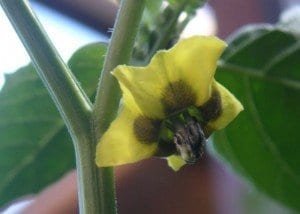“We’ve found compounds from the wild tomatillo that have strong anti-cancer properties against breast cancer, skin cancer, thyroid cancer and brain cancer in our early studies,”
For decades the native prairie plant with tomato-like vines, and marbled-sized fruit covered in thin husks, has sprawled across the Kansas prairie in relative obscurity.
But scientists from around the world are now noticing the wild tomatillo, and wondering if it might provide a major medicinal breakthrough.
“We’ve found compounds from the wild tomatillo that have strong anti-cancer properties against breast cancer, skin cancer, thyroid cancer and brain cancer in our early studies,” said Mark Cohen, cancer physician and research scientist who has been working with the plant for more than two years.
“It’s very exciting because not only do those compounds occur naturally, but they’re more potent than some drugs currently on the market for these diseases.”
Cohen said initial research has been done against human cancer cells in laboratory containers and mice. Things are progressing well enough that human-based trials could begin in about two years, he said.
It seems the deeper the botanists, medicinal chemists and cancer researchers dig into wild tomatillos, the more promise the prairie plant holds.
“We’ve found 15 new molecules in the plant previously not known to science,” said Barbara Timmermann, University of Kansas medicinal chemistry chair. “Nobody knew they existed and several of them are so active against cancer.”
And it’s not like this is some super-delicate plant from some far away corner of the Amazon.
Wild tomatillos, Physalis longifolia, are a tough, prolific prairie plant currently thriving over much of the central United States.
(They’re related to a domestic variety of tomatillo, but scientists don’t know if it has similar characteristics.)
But promised funding was abruptly cut less than halfway through the five-year research project.
“We are having fantastic data, and things are moving so well, then they just pulled the rug out from under us,” Timmermann said, of money from Heartland Plant Innovations. “It’s very unfortunate, and very disappointing.”
Natural pharmacy
The Native Medicinal Plant Research Program began in 2010 as a joint venture using the strengths of the Kansas Biological Survey, the KU School of Pharmacy and the KU School of Medicine.
Timmermann and Kelly Kindscher, a biological survey senior scientist, have long seen the Kansas prairies as a potential pharmacy waiting to be explored.
“Everybody has been going to the rain forest and other exotic places for research,” said Timmermann, who has about 30 years of experience researching medicinal plants, “but we knew the Midwest had so many plants nobody had ever really looked at.”
Kindscher, a noted expert on America’s prairies, had also learned that for centuries native tribes were utilizing a number of plants for medicinal purposes before the state was settled.
“They weren’t collecting them randomly,” Kindscher said. “They’d learned what to use, and used them in many cases fairly effectively.”
He said modern research has shown most do indeed work.
Kindscher said any medicinal benefits found in plant compounds are mostly coincidental. Most are produced to protect the plant in some way or another.
“Plants can’t run and they can’t just grow spines if they don’t have them, so they need some kind of chemical defense against being eaten by insects or something,” he said.
They also may help them survive tough conditions, like floods and drought.
While Kindscher and crew eventually provided about 200 different species of prairie plants for testing, wild tomatillos quickly gained the most attention because of the findings in Timmermann’s lab.
Great promise
As well as testing how the wild tomatillo compounds perform against cancer, the plants were also tested to see how they react to other kinds of human cells.
It would be possible, Cohen said, for a compound to be very aggressive against cancer but too toxic to healthy human cells to become a viable treatment.
Fortunately, that hasn’t been the case so far.
via Kansas.com – Michael Pearce – The Wichita Eagle
The Latest Streaming News: Wild tomatillo updated minute-by-minute
Bookmark this page and come back often
Latest NEWS
Latest VIDEO









